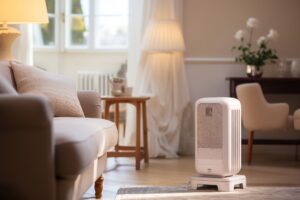
Formaldehyde removal in Singapore is an increasingly critical concern, especially in urban environments. One of the primary pollutants that can compromise indoor air quality is formaldehyde, a volatile organic compound (VOC) commonly found in building materials and furniture. For those looking to create healthier living spaces, incorporating low-formaldehyde wood materials is an excellent solution. In this article, we will explore the importance of formaldehyde removal in Singapore and how we can achieve this goal.
Understanding Formaldehyde and Its Impact
Formaldehyde removal in Singapore is vital due to the nature of formaldehyde as a colorless, pungent gas used in the production of resins that bind wood particles in engineered wood products like plywood, particleboard, and medium-density fiberboard (MDF). It is also found in various household items, including furniture, carpets, and adhesives. When these products produce formaldehyde, it can lead to indoor air pollution, which poses significant health risks.
Health Risks of Formaldehyde Exposure
Exposure to formaldehyde, both in the short-term and long-term, can pose significant health risks to individuals.
Irritation of Eyes, Nose, and Throat

Inhalation of formaldehyde vapors can cause irritation to the eyes, nose, and throat. Symptoms may include burning sensations, itching, and discomfort, which can be particularly bothersome in enclosed spaces where formaldehyde concentrations are elevated.
Chronic Respiratory Problems
Prolonged exposure to formaldehyde has been linked to the development of chronic respiratory conditions. This includes bronchitis, which involves inflammation of the bronchial tubes, and chronic obstructive pulmonary disease (COPD), a progressive lung disease characterized by obstructed airflow.
Allergic Reactions

Some individuals may develop allergic sensitization to formaldehyde over time. This can manifest as skin reactions (contact dermatitis), respiratory allergies (allergic rhinitis), or even systemic allergic responses upon exposure.
Carcinogenic Potential
Formaldehyde has been classified as a human carcinogen by the International Agency for Research on Cancer (IARC). Long-term exposure to formaldehyde has been associated with an increased risk of nasopharyngeal cancer and certain types of leukemia. The carcinogenicity of formaldehyde primarily affects those with prolonged occupational exposure, such as workers in industries involving wood processing, furniture manufacturing, and certain types of construction.
Neurological Effects
There is emerging evidence suggesting that formaldehyde exposure may extend its impact to neurotoxic effects, potentially affecting cognitive function and neurobehavioral performance in exposed individuals. These effects could manifest in various forms, such as impaired memory, concentration difficulties, and altered mood states.
Strategies for Formaldehyde Removal in Singapore
Prolonged exposure to formaldehyde can lead to various health issues, making its removal or reduction a top priority in interior design. To address formaldehyde concerns, several strategies can be employed:
Ventilation
Increasing ventilation by opening windows and using exhaust fans can help dilute indoor air pollutants, including formaldehyde. This approach allows fresh outdoor air to circulate indoors, reducing the concentration of formaldehyde and other volatile organic compounds (VOCs).
Air Purifiers

High-efficiency air purifiers with activated carbon filters can help remove formaldehyde from indoor air. These purifiers work by pulling air through a series of filters that trap airborne particles, including formaldehyde molecules.
Low-Formaldehyde Materials
Using materials with low or no formaldehyde content is the most effective way to reduce indoor formaldehyde levels. High-quality, low-formaldehyde wood materials, such as those from EGGER, are engineered to emit significantly lower levels of formaldehyde, ensuring safer indoor air quality. Formaldehyde removal in Singapore is greatly enhanced by utilizing these innovative materials.
Implementing Low-Formaldehyde Materials in Interior Design
Formaldehyde removal in Singapore can be seamlessly integrated into various design aspects.
Living Rooms
Using low-formaldehyde MFC for built-in cabinetry and shelving can drastically reduce formaldehyde levels. These solutions provide both safety and beauty.
Bedrooms
For bedrooms, especially children’s rooms, using low-emission products for furniture and storage solutions is essential. This includes beds, wardrobes, and study desks, ensuring that the air remains clean and safe for restful sleep.
Kitchens
In kitchens, where cabinets and countertops are predominant, utilizing low-formaldehyde materials is crucial. This includes cabinetry, shelving, and even flooring options that can help maintain air quality while providing a durable and attractive kitchen space.
Wardrobes
For wardrobes, using low-formaldehyde MFC or other low-emission materials can significantly reduce formaldehyde levels in the bedroom. This is particularly important for walk-in closets or built-in wardrobes, where clothes and personal items are stored, ensuring they remain free from harmful VOCs.
Benefits of Choosing Low-Formaldehyde Products
These are some important benefits of utilizing low-formaldehyde products for your home:
Healthier Indoor Air Quality
By significantly reducing formaldehyde emissions, these products contribute to better indoor air quality, which is vital for the health and well-being of occupants. Formaldehyde removal in Singapore becomes more manageable and effective with the use of these materials.
Sustainability
Low-formaldehyde wood based materials, eg from EGGER are produced using environmentally friendly manufacturing processes. This aligns with the growing demand for eco-friendly building materials, making it part of a broader commitment to sustainability.
Versatility and Aesthetics
Low-formaldehyde wood based materials from EGGER also offer a wide range of finishes and textures, allowing designers to create diverse looks while maintaining high environmental standards. Whether it’s a sleek modern kitchen or a cozy traditional living room, these products provide endless design possibilities.
Compliance with Standards
High-quality, low-formaldehyde materials, from EGGER, adhere to the highest formaldehyde emission standard of F**** / ENF, which currently offers the lowest formaldehyde emission available in the market. These materials are also certified with the Singapore Green Label, ensuring they meet stringent environmental and health standards. By choosing EGGER products for formaldehyde removal in Singapore, you can ensure healthier indoor air quality.
Conclusion
Formaldehyde removal in Singapore is a critical aspect of creating safe and healthy indoor environments. By choosing low-formaldehyde wood materials, you can significantly reduce the presence of harmful VOCs in their projects. These products meet stringent health and environmental standards and also offer a wide range of design possibilities, ensuring that you don’t have to compromise on style for the sake of safety. As awareness of indoor air quality continues to grow, integrating low-formaldehyde solutions into your designs will help create spaces that are both beautiful and beneficial for the health of their occupants.
Let E³.SPACE bring your dream home vision to life. Book an appointment today.

